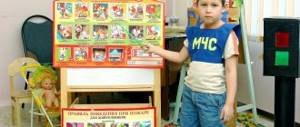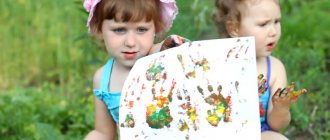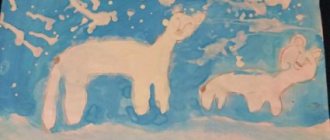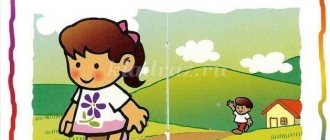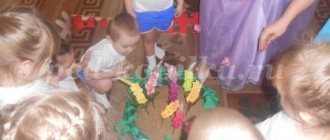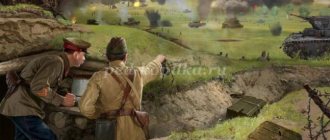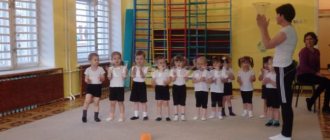Summary of a lesson on speech development in the 2nd junior group of a preschool educational institution. Pets and their babies
Summary of a lesson on speech development in the second junior group on the topic: “Pets and their babies”
Description of the material : I offer you a summary of organized educational activities for children of the second junior group (3-4 years old) on the topic “Pets and their babies”. This The summary is aimed at cultivating a love for animals, the caring attitude of adult animals towards children, cultivating interest in activities, creating a joyful mood in children.
Summary of an open lesson on speech development in the second junior group on the topic: “Pets and their babies”
Goals of the lesson: continue to teach children distinguish between adult animals and their young, teach to name and compare them by size - “big” and “small”, enrich children’s vocabulary, contribute to the development of sound expressiveness of speech: pronunciation of onomatopoeia loudly and quietly. Objectives: Educational: teach children to distinguish between adult animals and their young, promote the development of sound expressiveness of speech: pronouncing onomatopoeia loudly, quietly, in a thin voice. Strengthen the ability to construct a phrase of 3-5 words. Developmental:
develop children's imagination, curiosity, memory and thinking, increase children's speech activity, develop the ability to answer questions, develop visual perception.
Educational:
teach to listen carefully to the teacher, answer questions, evoke an emotional response, cultivate a caring attitude towards animals.
Integration of educational areas: “Cognition”
• domestic animals and their young, consolidate the name of geometric shapes.
“Communication”
• development of coherent speech in children.
“Health-saving”
• motor activity of children in physical education.
Demonstration material : Pictures of pets and their babies, hats, pet masks. Handout : pictures depicting domestic animals and their babies. Methodological techniques : game situation, conversation - dialogue, examination of illustrations, physical education minute, analysis, summing up. Preliminary work : conversation about animals, looking at illustrations on the topic: “Pets,” conducting didactic games.
Progress of the lesson:
1. Organizational moment Educator: - Guys, Grandma Masha sent us a letter, let's read it. Hello children! My beloved cat has lost her kitten, help us find it. - Guys, can we help? Children's answers : Yes Educator: Well then, let's hit the road. What will we go on? Children: - By bus! Educator: We take tickets, take seats according to our ticket (on chairs and on tickets, geometric shapes circle, square, etc.) took our seats, let's hit the road! (the bus song sounds). Educator: - Oh guys, look who’s sitting there? Children's answers: Kitten. Educator : Look, guys, the kitten is sad, why do you think? Children's answers : He lost his mother. Educator : Let's call Grandma Masha and ask maybe this is her kitten. - Grandma Masha asked you to describe him. Children's answers : small, white, fluffy…. Educator : Grandma Masha said that this is their loss, now we will bring him. Educator: Look guys, who are we visiting? Children : To Grandma Masha and to the cat’s mother. Educator : Guys, what benefits does a cat bring to a person? Children's answers : catches mice, rats - So what kind of animal is a cat? Children's answers: Pet. Grandma Masha comes out, thank you kids for bringing our “Fluffy”. Come visit me, I’ll introduce you to his mother. Educator: The cat's mother's name is Murka and she invites you to visit her to introduce you to her friends. Do you want to meet them? Children's answers : Yes. Educator: Look, the cat meets us not alone, but with her children. What are their names? That's right, kittens. Educator: - Guys, how does the cat purr? Meow loudly like a cat “Meow-meow”) - How does a kitten meow? (Meow softly like kittens, “Meow-meow”) - That’s right, guys. Educator: Guys, sit on the chairs. Educator: Do you want to know who the cat will introduce us to? Listen and guess the riddle. Riddle 1. He caresses his own people, but swears at strangers. At his little house he sits on a chain. Educator: That's right, Dog. I show a card with a picture of a dog. We put the picture on a magnetic board. Educator: - How does she bark? (Bark loudly like a big dog “Woof-woof”) - Who’s next to her? (this is her baby - a puppy) - How does the puppy bark? (Bark softly like puppies “Woof-woof”) - Is the dog big? What puppy? (and the puppy is small) Educator : Well done, guys. Want to meet another cat friend? Guess the riddle and find out who we are about to meet. Riddle 2. Who is jumping along the path? Clack-clack-clack. Who has such frisky legs? Clack-clack-clack. Her mane is silky, she is cheerful and playful. Her fur is so smooth, It’s running towards us... (A horse.) That’s right, a horse galloped towards us. Educator : Well done! Right. I show you a card with a picture of a horse. We put the picture on a magnetic board. Educator : What are the names of the baby horses? Children's answers: The horse's children are foals. Educator: What does a mother horse call her foal? (Igo-go-go) How do the foals respond? (yoke-yoke-yoke) Let us remember the poem about the horse. Who wants to tell? I love my horse, I will comb its fur smoothly. I’ll smooth my ponytail with a comb and go on horseback to visit. (A. Barto.) Educator : Well, let’s look beyond the friends of the cat Murka? Can you guess the next riddle? Riddle 3. A dirty little guy lies in a bristly shirt. The tail is a pretzel, the nose is a snout. Children answer : pig and piglets. Educator: Well done! Right. I show a card with a picture of a pig and piglets. We put the picture on a magnetic board. How does an adult pig grunt? Oink-oink. And the piglets: oink, oink. Educator: What kind of pig? What about the piglets? Educator: - Who else came, guys? Guess, here's the riddle: Riddle 4. A fur coat and a caftan walk across the mountains and across the valleys. Children's answers: Sheep Educator: Well done! Right. I show a card with a picture of a Sheep. We put the picture on a magnetic board. Educator: Who are the sheep's kids? Children's answers : Lambs How does the mother sheep call the lambs? be-be-be. How do her cubs respond? be-be-be. Educator: Well done, guys. Do you want to know more about our cat's friends? Guess the next riddle. Riddle 5. Every evening, so easily, She gives us milk. She says two words, What is her name - (cow). Children's answers : cow Teacher: That's right, cow. Showing a card with a picture of a cow. We put the picture on a magnetic board. Educator: Who can tell me the name of her cub? Children's answers : calf Educator : Correct - calf. How does he moo? (we hum subtly Mmu-oo-oo) Educator: You can also call a calf a bull. Let's do some physical exercises about a bull. Physical exercise. Bull and goby The bull's sides are steep. (Hands on the belt.) The bull has twisted horns. (Show the big steep horns of the bull above your head.) The bull has big legs, (Bend over the legs.) The bull has a strict character. (Wag your finger.) The bull has legs like sticks, (Stomp your feet.) The bull has funny horns. (Of the two index fingers - horns above the head.) The bull's tail is short, (The hand behind depicts a short tail.) The bull has a meek character. (The head tilts from side to side, a sweet expression on the face.) (E. Karganova) We seat the children. Educator : Guys, answer me, what are all these animals called? Children : At home. Educator: Why homemade? Children: Because the person takes care of them. Educator : How does he take care of them? Children : Feeds, waters, strokes, combs the fur. Correct, i.e. take care Educator : Guys, look at our magnetic board. The game “Who is Missing” is being played. Educator : Oh guys, look, while we were playing, the mothers lost their babies. Let's help mothers find their children. Pictures depicting domestic animals and their cubs are laid out on the tables. Pick up pictures of an animal and find its baby. - And the cat sits and looks at you to see if you are behaving well, she is watching you. Educator : Now you choose hats and pet masks. Oh-oh-oh, oh-oh-oh! An evil wizard has come to us! He waved his hands and bewitched all the guys. Now, my guys, you are kittens. How do kittens meow? Now, my guys, you are calves. How do calves moo? ...goats.....foals....puppies Children, accompanied by music, imitate the movements of domestic animals, changing the strength of their voices. Animal
friends came to us, They all gathered at the edge of the forest, Instantly they drove away the villain And the children were bewitched.
Hooray! To consolidate the material covered. Educator : Did you enjoy visiting Baba Masha and Murka? Now you know who the cat is friends with. Let's remember who the cat is friends with? Children's answers: he is friends with the horse, he is friends with the cow, he is friends with the dog, etc. The teacher summarizes the answers: because we have pets. Educator: That's it, our lesson is over. We will say goodbye to Grandma Masha and Murka. Let's wave and say goodbye and quietly leave our group.
We recommend watching:
Summary of educational activities for speech development in the 2nd junior group. Forest walk Summary of a lesson on speech development in the younger group Lesson on speech development and drawing for children of the younger group Summary of educational activities for speech development using a regional component for the younger group
Similar articles:
Lesson notes on speech development in the second junior group

